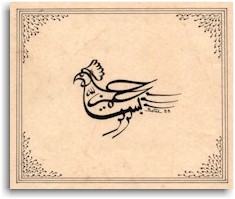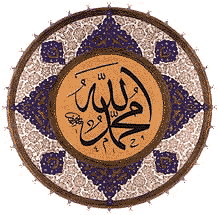TURKISH ART

CALLIGRAPHY / Decorative Turkish Arts

The first thing that comes to mind whenever calligraphy is mentioned is the decorative use of Arabic letters. This art emerged after a long period between the 6th and 10th centuries as Arabic letters evolved.
After turning to Islam and adopting the Arabic alphabet, the Turks failed to play any part in the art
of calligraphy for a long time. They first began to show an interest in it after moving to Anatolia, and the Ottoman period was one of the times during which it flourished most. Yakut-ı Mustasımi was particularly influential in Anatolia from the beginning of the 13th century to the middle of the 15th. Şeyh Hamdullah (1429-1520) made a number of changes to the rules introduced by Yakut-ı Mustasımi, thus giving Arabic letters are warmer, softer appearance. Şeyh Hamdullah is regarded as the father of Turkish calligraphy, and his style and influence predominated until the 17th century. It was Hafız Osman (1642-1698) who produced the art's most aesthetically mature period. All the great calligraphers who came after basically followed in Hafız Osman's footsteps.
As well as the six main styles of calligraphy, the Turks also created a new style from the 'talik' form discovered by the Persians. The early examples of this 'talik' style were

"Zoomorphic" calligraphy: the script means "
In the name of God" and forms a bird; its neckband reads "O merciful, O Compassionate".
heavily influenced by Persia, but in the 18th century mehmed Esad Yesari (died 1798) and his son Yesari Mustafa İzzet (died 1849) gave it a whole new appearance. Turkish calligraphy continued to shine in the 19th and 20th centuries. With the adoption of the Latin alphabet in 1928, however, it ceased to be a popular art form, becoming merely a traditional art taught in a certain number of schools.
ILLUMINATION AND GILDING / Decorative Turkish Arts
Known as 'tezhip' in Turkish, this is an old decorative art. The word 'tezhip' means 'turning gold' or 'covering with gold leaf' in Arabic. Yet 'tezhip' can be done with paint as well as with gold leaf. It was mostly employed in handwritten books and on the edges of calligraphic texts.

The art of ilumination has been practiced as widely in the West as it has in the East. In the Middle Ages in particularly it was widely used to decorate Christian religious texts and prayer books. Gradually however, picture illustrations became more popular, and illumination became restricted to decorating the capital letters in main headings.
Among the Turks, the history of illumination goes back to the Uyghurs, and first began to be seen among the Uyghur people in the 9th century. The Selujks then brought it to Anatolia, and the art saw its culmination in Ottoman times. Mameluke artists in 15th century Egypt developed their own style, and great advances in the art of illumination were made at the same time in Persia and then in such cities as Herat, Hive, Bukhara and Samarkand which were ruled by the Timurs. The style that developed in Herat later had great influence on the Persian art of illimunation. As a result of growing ties with Persia in the 15th and 16th centuries, the Ottomans adopted many of the features of the Herat School in their own work, and created new syntheses. In the 18th century, the Ottoman art of illumination began to fade, with crude decoration replacing the classical motifs. In the 19th century, the Western influence that could be seen in almost all areas of art also began to make its presence felt in the art of illumination. For example, flower motifs that used to be employed singly on vases during the classical period now began to appear in groups in pots.
The main ingredient in illumination is gold or paint. Gold is used in a thin leaf prepared by beating it to an extreme fineness. The gold leaf is powdered in water and mixed with gelatine, and then brought to the desired thickness. Earth paints tended to be preferred in terms of paint, although synthetic paints were employed later. The illuminator, known as the 'müzehhip,' first uses a needle to impress the designs he has drawn onto paper attached to a hard boxwood or zinc base. He then places the perforated paper onto the material he intends to decorate, and fills the holes with a sticky, black powder. When the paper is removed, the design is left behind. The motif is then rounded out and filled with the gold leaf or paint.
MINIATURE WORK / Decorative Turkish Arts
This is the name given to the art of producing very finely detailed, small paintings. In Europe in the Middle Ages, handwritten manuscripts would be decorated by painting capital letters red. Lead oxide, known as 'minium' in Latin and which gave a particularly pleasant colour, was used for this purpose. That is where the word 'miniature' derives from. In Turkey, the art of miniature painting used to be called 'nakış' or 'tasvir,' wit
 h the former being more commonly employed. The artist was known as a 'nakkaş' or 'musavvir.' Miniature work was generally applied to paper, ivory and similar materials.
h the former being more commonly employed. The artist was known as a 'nakkaş' or 'musavvir.' Miniature work was generally applied to paper, ivory and similar materials.The miniature is an art style with a long history in both the Eastern and Western worlds. There are those, however, who maintain that it was originally an Eastern art, from where it made its way to the West. Eastern and Western miniature art is very similar, although differences can be observed in colour, form and subject matter. Scale was kept small since the art was used to decorate books. That is a common characteristic. Eastern and Turkish miniatures also possess a number of other features. The outside of the miniature is usually decorated with a form of embellishment known as 'tezhip.' A paint similar to water colour was used for miniatures, although rather more gum arabic was used during the mixing process. Very thin brushes made from cat fur and known as 'fur brushes' were used to draw the lines and fill in the fine detail. Other brushes were employed for the painting itself. White lead with gum Arabic added was applied to the surface of the paper to be painted. A thin coat of gold powder would also be applied to the surface to make the various colours transparent.
The oldest known miniatures were done on papyrus in Egypt in the 2nd century BC. Handwritten manuscripts decorated with miniatures can then be observed in the Greek, Roman, Byzantine and Syriac periods. With the spread of Christianity, miniatures began to be used to ornament the Bible in particular. The development of the art came towards the end of the 8th century. In the 12th century, miniatures ceased to be directly linked in form to the text they were decorating, and also ceased to be exclusively religious in tone, with secular examples appearing. Beautiful and splendid miniatures continued to be created in Europe until the development of the printing press. After that time, they were more usually used in the form of portraits on the backs of medallions. After the 17th century, the application of miniatures to ivory began to spread. Later still, as interest in the art of the miniature began to fall, it continued as a traditional art
 form among a small number of artists.
form among a small number of artists.Great importance was attached to the miniature during the Seljuk period. Seljuk miniature was considerably influenced by Persia, on account of their close relations with that country. They also produced Abdüddevle, who painted a portrait of Mevlana, and other famous miniaturists. In the Ottoman Empire, the Seljuk and Persian influence continued up until the 18th century. During the time of Sultan Mehmet the Conqueror, a miniaturist by the name of Sinan Bey made a portrait of the sultan, and also trained another artist called Baba Nakkaş during the reign of Bayezid II. In the 16th century, the artists Nigari, known as Reis Haydar, Nakşi and Şah Kulu won considerable renown. During that same time, Aka Mirek of Horasan, a student of Bihzad, was called to Istanbul and made 'başnakkaş' or chief artist. Mustafa Çelebi, Selimiyeli Reşid, Süleyman Çelebi and Levni were the best known miniaturists of the 18tth century. Of these, levn' constituted a turning point in Turkish miniature painting. Levn' moved beyond the traditional conception of the art and developed his own unique style. Under the influence of the renewal movements in the 19th century, Western art also began to affect the art of miniature painting. The miniature slowly began to give way to contemporary art as we understand the concept today. However, it still survives as a traditional art in Turkey, in the same was as it does in the West.
MARBLING / Decorative Turkish Arts
The art of marbling on paper, or 'ebru' in Turkish, is a traditional decorative form employing special methods. The word 'ebru' comes from the Persian word 'ebr,' meaning
 'cloud.' The word 'ebri' then evolved from this, assuming the meaning 'like a cloud' or 'cloudy,' and was assimilated into Turkish in the form 'ebru.' Marbling does actually give the impression of clouds. Another possible derivation of the word 'ebru' is
'cloud.' The word 'ebri' then evolved from this, assuming the meaning 'like a cloud' or 'cloudy,' and was assimilated into Turkish in the form 'ebru.' Marbling does actually give the impression of clouds. Another possible derivation of the word 'ebru' is from the Persian 'âb-rûy,' meaning 'face water.'
from the Persian 'âb-rûy,' meaning 'face water.'Although it is not known when and in which country the art of marbling was born, there is no doubt that it is a decorative art peculiar to Eastern countries. A number of Persian sources report that it first emerged in India. It was carried from India to Persia, and from there to the Ottomans. According to other sources, the art of marbling was born in the city of Bukhara in Turkistan, finding its way to the Ottomans by way of Persia. In the West, 'ebru' is known as 'Turkish paper.'
6 Comments:
パソコン自作
アフィリエイト
ブログアフィリエイト
多重債務
投資
お取り寄せグルメ
横浜中華街
不動産
ウィークリーマンション
復旧
発電
価格
toefl
データ復旧
ショッピング枠 現金化
テレマーケティング
横浜 賃貸
釣り
害虫駆除
株式投資
賃貸
データ復旧
介護
不動産担保ローン
ウエディング
ウエディングドレス
看護師
自動車保険
ホテヘル
レストランウェディング
バイク買取
運転免許
ベビーカー
外反母趾
圧力鍋
腕時計
フェラガモ
デリヘル
キャバクラ
セレブ
プラセンタ
カルシウム
青汁
ブルーベリー
家具
脱毛クリーム
除毛クリーム
コスト削減 大阪
弁護士 大阪
車買取 大阪
バイク買取 大阪
エステ 大阪
リフォーム 大阪
大阪 歯科
派遣 大阪
アルバイト 大阪
転職 大阪
大阪 住宅
大阪 専門学校
グルメ 大阪
ホテル 大阪
一戸建て 大阪
大阪 宿泊
大阪 マンション
デリヘル 大阪
印刷 大阪
不動産 大阪
賃貸 大阪
ブライダル 大阪
リサイクル
アダルト SEO
賃貸
SEO 大阪
イベント コンパニオン 大阪
転職 大阪
大阪 ラブホ
ペット ショップ 大阪
豆腐
京都 不動産
運転免許 合宿
ヘアアイロン
ダイエット
ダイエット
デリヘル
キャバクラ
大阪 デリヘル
仙台 デリヘル
仙台 デリヘル
仙台 デリヘル
家族葬
滋賀 賃貸
キャッシング
大阪 賃貸
中古車 販売
ルームウェア
大阪 マンション
賃貸マンション 神戸
中古 ゴルフクラブ
クールビズ
フィットネスクラブ
大阪府 司法書士
クレジット 申し込み
ベビードール
矯正歯科 東京
ホワイトニング 東京
大阪 ラブホテル
リサイクルショップ
不動産
カードローン
投資 信託
下着
即日 キャッシング
三井住友銀行
神戸市 中央区 税理士
FX
消費者金融
ローン
引越し
生命保険
ジェルネイル
人材派遣
ネット証券
アフィリエイト
格安航空券
ウィークリーマンション
レンタカー
SEO
オフィス家具
合宿免許
ペット用品
高速バス
デリヘル
キャバクラ
派遣
コラーゲン
化粧品
インテリア
ウェディング
結婚相談
投資物件
留学
貸事務所 大阪
経営コンサルティング
工芸品
高級品
大阪 デリヘル
台灣汽車旅館加盟網--
台北汽車旅館,
台中汽車旅館,
高雄汽車旅館牛初乳保洁公司台灣汽車旅館加盟網--
台中汽車旅館,
高雄汽車旅館牛初乳保洁公司台北汽車旅館,
台中汽車旅館,
牛初乳保洁公司台灣汽車旅館加盟網--
台北汽車旅館,
牛初乳保洁公司台中汽車旅館,
高雄汽車旅館牛初乳保洁公司
白髪染め
白髪染め
白髪染め
白髪染め
白髪染め
白髪染め
白髪染め
白髪染め
白髪染め
白髪染め
白髪染め
白髪染め
白髪染め
白髪染め
白髪染め
白髪染め
白髪染め
白髪染め
白髪染め
白髪染め
白髪染め
白髪染め
白髪染め
白髪染め
白髪染め
白髪染め
白髪染め
Post a Comment
<< Home